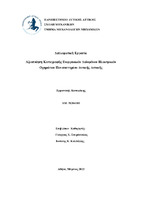| dc.contributor.advisor | Spyropoulos, Georgios | |
| dc.contributor.advisor | Καλδέλλης, Ιωάννης | |
| dc.contributor.author | Κανακάκης, Εμμανουήλ | |
| dc.date.accessioned | 2022-03-30T06:49:40Z | |
| dc.date.available | 2022-03-30T06:49:40Z | |
| dc.date.issued | 2022-03-03 | |
| dc.identifier.uri | https://polynoe.lib.uniwa.gr/xmlui/handle/11400/2018 | |
| dc.identifier.uri | http://dx.doi.org/10.26265/polynoe-1869 | |
| dc.description.abstract | Σκοπός της παρούσας Διπλωματικής Εργασίας είναι η αξιοποίηση της καταγραφής των ενεργειακών δεδομένων των ηλεκτρικών οχημάτων του Πανεπιστημίου Δυτικής Αττικής, με σκοπό την εξαγωγή συμπερασμάτων με έμφαση στη κατανάλωση ηλεκτρικής ενέργειας. Αρχικά, γίνεται μια εκτεταμένη αναφορά βάσει της υπάρχουσας βιβλιογραφίας, στις εκπομπές διοξειδίου του άνθρακα από τον τομέα των μεταφορών και την ανάγκη για μετάβαση σε οχήματα με μηδενικές εκπομπές ρύπων. Στη συνέχεια, γίνεται σύγκριση του βαθμού απόδοσης και της κατανάλωσης ενέργειας μεταξύ συμβατικών και ηλεκτρικών οχημάτων, ενώ παράλληλα
αναλύονται και κατηγοριοποιούνται οι απώλειες ενέργειας των ηλεκτρικών αυτοκινήτων. Έπειτα, παρουσιάζονται τα δύο ηλεκτρικά οχήματα του Πανεπιστημίου Δυτικής Αττικής και γίνεται αναλυτική περιγραφή των τεχνικών τους χαρακτηριστικών. Παράλληλα γίνεται σύντομη αναφορά στον σταθμό φόρτισης του Πανεπιστημίου Δυτικής Αττικής και στο σύστημα καταγραφής των δεδομένων φόρτισης Carlo Gavazzi. Επιπροσθέτως, περιγράφεται η διαδικασία αναζήτησης εξοπλισμού καταγραφής των ενεργειακών δεδομένων των δύο ηλεκτρικών οχημάτων που μελετώνται στη παρούσα εργασία, ενώ παράλληλα παρατίθενται τα στοιχεία που
αντλήθηκαν έπειτα από εκτενή έρευνα. Το επόμενο βήμα είναι η περιγραφή της διαδικασίας που τηρήθηκε για την λήψη των δεδομένων οδήγησης και φόρτισης των δύο ηλεκτρικών οχημάτων που μελετώνται. Τέλος, παρουσιάζονται τα αποτελέσματα που προέκυψαν από την επεξεργασία των δεδομένων για το ηλεκτρικό όχημα και το ηλεκτρικό λεωφορείο, αξιολογούνται τα
ευρήματα της έρευνας και εξάγονται τα προκύπτοντα συμπεράσματα. | el |
| dc.format.extent | 153 | el |
| dc.language.iso | el | el |
| dc.publisher | Πανεπιστήμιο Δυτικής Αττικής | el |
| dc.rights | Αναφορά Δημιουργού - Μη Εμπορική Χρήση - Παρόμοια Διανομή 4.0 Διεθνές | * |
| dc.rights.uri | https://creativecommons.org/licenses/by-nc-sa/4.0/deed.el | * |
| dc.subject | Ηλεκτρικά οχήματα | el |
| dc.subject | Ανάλυση δεδομένων | el |
| dc.subject | Κατανάλωση ενέργειας | el |
| dc.subject | Electric vehicles | el |
| dc.subject | Data analysis | el |
| dc.subject | Energy consumption | el |
| dc.title | Αξιοποίηση καταγραφής ενεργειακών δεδομένων ηλεκτρικών οχημάτων Πανεπιστημίου Δυτικής Αττικής | el |
| dc.title.alternative | Energy data recording utilization of electric vehicles of the University of West Attica | el |
| dc.type | Διπλωματική εργασία | el |
| dc.contributor.committee | MOUSTRIS, KONSTANTINOS | |
| dc.contributor.committee | Ζαφειράκης, Δημήτριος | |
| dc.contributor.faculty | Σχολή Μηχανικών | el |
| dc.contributor.department | Τμήμα Μηχανολόγων Μηχανικών | el |
| dc.description.abstracttranslated | The purpose of this Thesis is the utilization of the energy data of the electric vehicles of the University of West Attica, in order to draw conclusions with emphasis on energy consumption. Initially, an extensive reference is made based on the existing literature on carbon dioxide emissions from the transport sector and the need for a transition to zero-emission vehicles. Further, the efficiency and energy consumption between conventional and electric vehicles is compared, while the energy losses of electric vehicles are analyzed and categorised. Then, the two electric vehicles of the University of West Attica are presented and their technical characteristics are described in detail. At the same time, a brief reference is made to the charging
station of the University of West Attica and the Carlo Gavazzi data recording system. In addition, the process of searching for equipment to record the energy data of the two electric vehicles studied in this paper, is described and the data obtained after extensive research are presented. The next step is the description of the procedure followed to obtain the driving and
charging data of the two electric vehicles studied. Finally, the results obtained from the data processing for the electric vehicle and the electric bus are presented, the research findings are evaluated and the resulting conclusions are drawn. | el |


